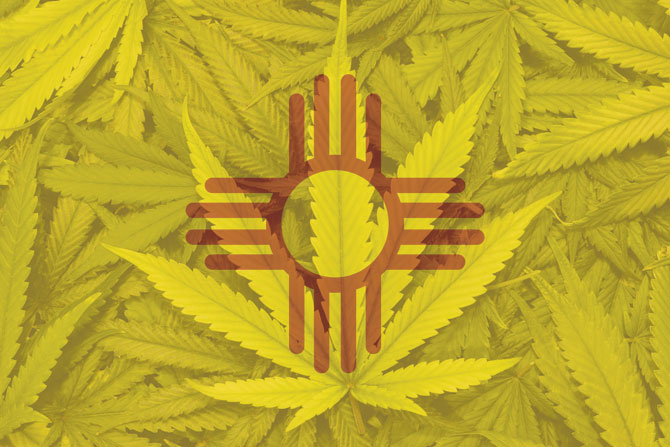In the wake of the COVID-19 pandemic and the subsequent economic fallout, many states are becoming more active and creative in promoting local economic solutions. Desperate times tend to force the hands of elected officials and inspire the quest for nontraditional solutions. In New York state, Governor Andrew Cuomo, facing multiple mushrooming scandals, decided to relent and sign a law that legalized recreational marijuana in his state, a logical move he was opposed to until he became desperate enough to relent. Here in New Mexico, however, our governor was the one pushing for recreational cannabis legalization, bringing the state’s Legislature back into Special Session to pass the legislation. New Mexico Governor Michelle Lujan Grisham listed marijuana legalization as a top priority entering the Legislature and, despite some hurdles, accomplished the goal.
New Mexico becomes the 17th state to pass legalized recreational marijuana, the vast majority of which passed their laws through direct ballot initiatives. New Mexico joins Vermont, Illinois, and New York to pass legalization through the Legislature. Passing a somewhat controversial piece of legislation is more difficult in generally risk-averse legislative bodies than opening it up to the public in the form of a ballot initiative. The general public tends to want progress at a much faster rate than most of our elected officials, so the credit must go to Governor Lujan Grisham for taking a hardline approach and forcing the Legislature to pass something they weren’t able to during the regular session. This approach is the inverse to what many Americans are accustomed to seeing, which is elected officials regularly disregarding the desires of their constituents in favor of more powerful, organized interests. The result showed the Governor prioritizing a piece of legislation that is overwhelmingly popular with New Mexicans.
In a poll from October 2020, 72% of New Mexicans indicated they favor recreational marijuana legalization. So, the bill made sense both from a policy perspective and a political perspective. It will create greater economic opportunities and social equity, and it has overwhelming public support. Lujan Grisham had been pushing for recreational legalization for multiple legislative sessions, but the economic difficulties created by the pandemic created a natural opportunity to make a case for legalization. In 2019, the New Mexico House approved a legalization bill that would have limited marijuana sales to mostly state-run stores. Frankly, the 2019 bill was somewhat ill-conceived and would have largely defeated the purpose of legalization. The 2021 legislation is far more comprehensive and economically viable. The provisions of the legalization bill include:
- Adults 21 and older can purchase and possess up to 2 ounces of cannabis, 16 grams of cannabis concentrates and 800 milligrams of infused edibles. Licensed laboratories will test all products for contamination and potency.
- Home cultivation of up to six mature cannabis plants will be allowed for personal use, provided the plants are out of public sight and secured from children. Households will be limited to 12 total plants. Marijuana grown at home cannot be sold or bartered.
- Legal retail sales won’t begin for another year or so, with a target date of April 1, 2022, or earlier. Final license rules will be due from the state by Jan. 1, 2022, with licenses themselves issued no later than April 1.
- Cannabis purchases will include a 12% excise tax on top of the state’s regular 8% sales tax. The excise rate will increase 1% each year, beginning in 2025, until it reaches 18% in 2030. Medical marijuana products, available only to patients and caretakers, would be exempt from the tax.
- Legislators wanted to ensure medical patients can still access medicine after the adult-use market opens. The bill allows the state to force licensed cannabis producers to reserve up to 10% of their products for patients in the event of a shortage or grow more plants to be used in medical products.
- There is no limit on the number of business licenses granted or the number of facilities a licensee could open under the program. However, regulators could stop issuing new licenses if an advisory committee determines that “market equilibrium is deficient.”
Small cannabis microbusinesses, which can grow up to 200 plants, will grow, process and sell cannabis products all under a single license. The bill’s backers have said the separate license type will allow wider access to the new industry for entrepreneurs without access to significant capital.
In addition to the legalization bill, New Mexico also passed SB 2, which expunges criminal records for cannabis convictions that are now legal and allows for individuals currently in custody for cannabis crimes to become eligible for resentencing. The accompanying expungement legislation is crucial. It ensures a more equitable future around cannabis and corrects many of the wrongs caused by its senseless prohibition.
The marijuana legalization issue is certainly worth close examination. It shows how quickly public opinion can be shifted. In 2005, polling generally indicated that around 35% of Americans favored legalization, and around 65% did not. In recent national polling, figures are generally around 70% supporting legalization and around 30% against. In only 15 years, the American public has essentially done a complete about-face on the issue of marijuana legalization. There are numerous reasons for this, but, most notably, the relentless propaganda around marijuana has subsided, allowing American citizens to make more rational, informed decisions around the issue. American popular culture depicted marijuana for many years as having wildly hallucinatory effects. It also said the average marijuana user stayed permanently glued to the couch with no desire for education or employment. In recent years, however, it has become clear to many people that it’s entirely possible to be both a marijuana user and a highly functional member of society.
Past depictions of marijuana users were, of course, broadly drawn stereotypes meant to obscure the real debate. Why is a substance that is certainly less dangerous than other legal substances being stigmatized and placed under prohibitive restrictions? A lot of the popular consensus around the illegality of marijuana had to do with myths and falsehoods. The more those myths began to be shattered, the more the American public began to be swayed on the issue. The passage and success of legal recreational marijuana in multiple states, including Colorado, certainly helped shatter some of the myths. Sometimes, to sway public opinion, something must be seen as “mainstream” and not part of some fringe outside culture before it can gain wide-scale public acceptance. That certainly seems to be the case with marijuana. Marijuana, like any substance, can be abused and not be ideal for certain individuals. But those points often don’t enter the equation when Americans discuss the legality of alcohol. Alcohol has been legal for so long that Americans accept it. We’ve been conditioned not to question its legality, so it has none of the caveats that exist with other substances. As marijuana use has become more mainstream in recent years, many of the caveats surrounding its use have been dropped.
The marijuana legalization issue is certainly worth close examination. It shows how quickly public opinion can be shifted. In 2005, polling generally indicated that around 35% of Americans favored legalization, and around 65% did not.
The dramatic shift in opinion around marijuana legalization shows how important it is for the public to be supplied with correct, objective information. When people are supplied with correct information not designed to propagandize, they tend to make more rational decisions around health care, the economy, drug policy and other important issues. Most people are not fundamentally irrational or illogical, but the propaganda they’re often inundated with can be. It’s encouraging to see a positive shift in public opinion around an issue because it shows it’s possible with myriad other issues if people are supplied with correct information.
Another aspect of marijuana legalization worth examining is how elected officials can use their power and leverage to great effect. Unfortunately, in the United States, we often see elected officials using their power to solely benefit their largest donors or acting as if they don’t hold any power. When average Americans demand action from elected officials, the customary reactions tend to be along the lines of, “Forces far beyond my control don’t allow me to act. I wish I could, but I can’t.” Public officials are masters at feigning powerlessness.
In both New York and New Mexico, power and leverage have been used to pass important legislation. In New York, Governor Cuomo felt pressure from his constituents and Legislature due to multiple scandals and, since he wanted to preserve his power, he enacted a popular measure. On the other hand, Governor Lujan Grisham used her power to pressure a reluctant legislature to pass an important legislative priority. In both cases, the pressure was exerted on elected officials using leverage and power. The New York Legislature exerted pressure on Governor Cuomo using its power, while Governor Grisham exerted pressure on the New Mexico Legislature using her leverage and power.
New Mexicans should be heartened to learn that their governor is willing to use her position to enact legislation that is popular with huge percentages of the population. Citizens often feel completely left out of the legislative process, but Governor Lujan Grisham has reminded us how much power elected officials have to accomplish positive goals. Her success was the essence of being an elected official.










